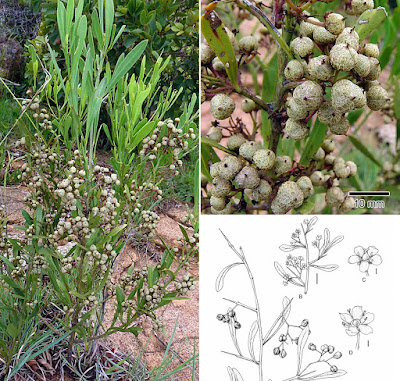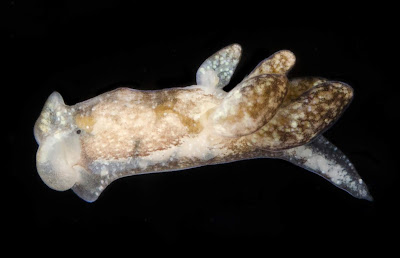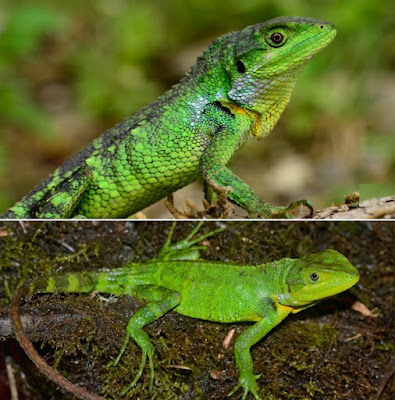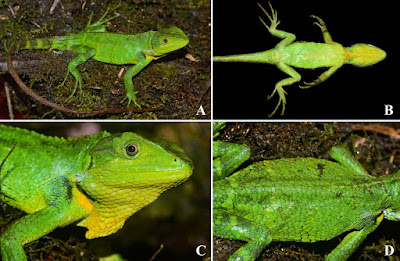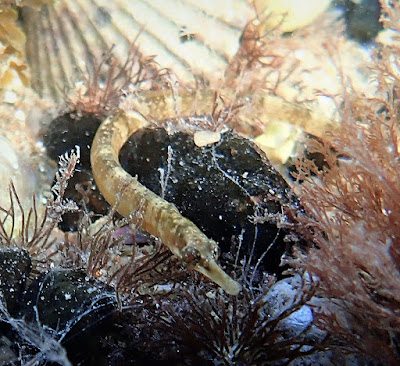[Most Recent Entries] [Calendar View]
Sunday, June 30th, 2019
| Time | Event | ||
| 8:02a | [Botany • 2019] Gymnosporia sekhukhuniensis (Celastraceae) • A New Species from South Africa Abstract Gymnosporia sekhukhuniensis, a new species from north-eastern South Africa, is described, illustrated, mapped, and compared with closely related species. It belongs to Gymnosporia sect. Buxifoliae, more specifically Group 1, the members of which are characterized by the capsules being (2)3(4)-valved, rugose or verrucose, and the seeds partially covered by the aril. The new species has a restricted distribution range and is near-endemic to the Sekhukhuneland Centre of Endemism. This biogeographical region rich in restricted-range plants is more or less congruent with surface outcrops of mafic and ultramafic igneous rocks belonging to the Rustenburg Layered Suite of the eastern Bushveld Complex. The range of the new species shows marginal intrusion into the far northern part of the nearby Wolkberg Centre of Endemism, where it is associated with dolomites of the Malmani Subgroup. Gymnosporia sekhukhuniensis is a suffrutex mainly associated with rocky outcrops in open savannah. Diagnostic characters include its dwarf habit (up to 1.6 m tall), capsules that are relatively small (5–8 mm long), woody, scaly-rugose, with hard pointed apices, and leaves that are very laxly arranged on the stems, with some often present on the thorns. Also included is a key to the 10 currently accepted species in G. sect. Buxifoliae Group 1. The taxonomic significance of capsule and seed characters for demarcating sections and species in the genus Gymnosporia is emphasized. Keywords: endemism, Gymnosporia sect. Buxifoliae, morphology, sections, Sekhukhuneland, taxonomy, ultramafic soils, Wolkberg, Eudicots Gymnosporia sekhukhuniensis Jordaan & A.E.van Wyk, sp. nov. Closely related to Gymnosporia heterophylla (Ecklon & Zeyher 1834–1835: 120) Loesener (1892: 207), with which it shares being a suffrutex with the stems angular-ribbed and in having capsules with a rugose surface, but from which it differs in the leaves being laxly arranged on the stems (vs. very densely and compactly), usually longer than 35 mm (vs. usually shorter than 20 mm), and capsules with apices apiculate (vs. rounded). Also related to the widespread G. buxifolia (Linnaeus 1753: 197) Szyszylowicz (1888: 34), from which it differs in being a suffrutex up to 1.6 m tall (vs. usually a shrub or tree more than 2 m tall), with stems angularribbed (vs. terete) and capsules 5–8 mm long (vs. usually less than 5 mm long), with apices apiculate (vs. not apiculate). Etymology:— The specific epithet is derived from Sekhukhuneland, the region to which the species is largely confined. Distribution:— Occurs along the north-eastern Great (Drakensberg) Escarpment of the Limpopo and Mpumalanga Provinces of South Africa and is considered near-endemic to the Sekhukhuneland Centre of Endemism, with marginal intrusion into the far northern adjoining part of the Wolkberg Centre of Endemism (Van Wyk & Smith 2001) (Fig. 3). Common names:— The proposed common names for this plant are Sekhukhune spikethorn, sekhukhunependoring (Afrikaans). Marie Jordaan and Abraham van Wyk. 2019. Gymnosporia sekhukhuniensis (Celastraceae), A New Species from South Africa. Phytotaxa. 408(1); 69–76. DOI: 10.11646/phytotaxa.408.1.5 | ||
| 8:44a | [Mollusca • 2019] Olea hensoni • Eggs Sunny-side Up: A New Species of Olea, An Unusual Oophagous Sea Slug (Gastropoda: Heterobranchia: Sacoglossa), from the western Atlantic
Abstract Nearly all of the recognized species of sea slugs in clade Sacoglossa (about 300 taxa) are herbivorous, using a uniseriate radula in suctorial feeding. The only exceptions are a pair of monotypic genera in the ceratiform family Limapontiidae: Olea Agersborg, 1923 from the northeastern Pacific, and Calliopaea d’Orbigny, 1837 from the northeastern Atlantic coast of Europe and the Mediterranean. Both genera feed on the eggs of other heterobranchs, notably cephalaspideans, and lack cerata on the anterior dorsum. Major differences are that C. bellula d’Orbigny, 1837 has more cerata than O. hansineensis Agersborg, 1923, a more typical radula with ascending and descending rows of fully-formed teeth, and a much longer penial stylet. Here, we describe a new egg-eating sacoglossan species from the subtropical Gulf of Mexico coast of Florida, U.S.A. Phylogenetic relationships inferred from analyses of a four-gene dataset including 219 sacoglossan species indicated the new taxon (Olea hensoni n. sp.) belongs to Olea. The generic placement of the new species is also supported by its highly reduced radula and comparatively short penial stylet. A full description of the reproductive, digestive, and nervous systems is also provided. Finding a new Olea species in the warm waters of the western Atlantic was surprising, given the genus was previously known only from the cold northern Pacific, and suggests further diversity in oophagous sacoglossans may await discovery. Keywords: Gastropoda, biogeography, integrative taxonomy, oophagy, radula, species discovery, systematics Hilton Galvão Filho, Gustav Paulay, Patrick J. Krug. 2019. Eggs Sunny-side Up: A New Species of Olea, An Unusual Oophagous Sea Slug (Gastropoda: Heterobranchia: Sacoglossa), from the western Atlantic. Zootaxa. 4614(3); 541–565. DOI: 10.11646/zootaxa.4614.3.7 Egg-sucking sea slug from Florida’s Cedar Key named after Muppets creator Jim Henson FloridaMuseum.UFL.edu/science/egg-sucking-sea-slug-fr Egg-sucking sea slug from Florida's Cedar Key named after Muppets creator Jim Henson phys.org/news/2019-06-egg-sucking-sea-sl | ||
| 8:49a | [Herpetology • 2019] Pseudocalotes austeniana (Annandale, 1908) • Range Extension of the Rare Agamid (Sauria, Draconinae) in the East Himalaya, with Comments on Its Ontogenetic Shift
Abstract Despite its recognition since the early 1900s, the agamid lizard Pseudocalotes austeniana remains known based on 3 vouchered specimens only from the East Himalaya, and little is known about its general biology. During herpetological surveys of Tibet, China, we collected 3 specimens of P. austeniana from Medog County, southeastern Tibet, including the first juvenile specimen ever vouchered. We provide a detailed description based on new material of this enigmatic species, report on a range extension of 400 km northeastward from its type locality, its ontogenetic shift, and clutch size. Keywords: Agamidae, Himalaya, Mictopholis, Salea, synonym Pseudocalotes austeniana (Annandale, 1908) Salea austeniana Identification. The recently collected adult and juvenile specimens from Tibet resemble closely the pholidosis characteristics of the vouchered holotype and topotypic specimen of Pseudocalotes austeniana (Table 1). In summary, these specimens are identified as P. austeniana based on the following morphological characters (following Mahony 2010): (1) tympanum exposed; (2) sub-ocular scale row singular, or multiple but one distinctively enlarged; (3) head robust, HW/HL > 59.7%, HD/HW > 72%, HD/HL > 43%; (4) distinct, strongly-developed cranial ridges present on dorsal and lateral surfaces of occipital region of head, forming rectangular, convex areas on temporal region of head and triangular concave area on posterior lateral region of head; (6) postorbital and postoccipital spines absent; (7) nuchal crest in triangular shape or short lanceolate shape, not strongly differentiated from dorsal crests; (8) mid-dorsal scale count less than 39; (9) longitudinal gular fold present, highly developed in dewlap, with a distinct, pointy tip toward posterior end; (10) transverse gular fold absent; (11) dorsal scales heterogeneous in size and shape, flat, feebly keeled or smooth, arranged irregularly in most parts, some enlarged ones in approximate transverse rows; (12) enlarged scales of dorsum not arranged into clear dorsolateral or V-shaped rows; (13) ventral body scales smooth or feebly keeled, larger than background dorsal scales, distinctively heterogeneous in size and shape, irregularly arranged; (14) antehumeral fold present; and (15) axillary fold present. ... Distribution range. Prior to our observations of Pseudocalotes austeniana in the field, the species was thought to be a rare endemic to the southern parts of Southern Tibet (Mahony 2010, Venugopal 2010, 2013), and the species was not officially listed as a member of the Chinese herpetofauna (Zhao and Jiang 1977, Zhao and Adler 1993, Zhao et al. 1999, Cai et al. 2015). However, the newly discovered populations represent a range expansion of about 400 km northeastward from the species’ previous range limits in the East Himalaya. Given the recognized habitat connectivity and similar environment spanning this region, it is likely that P. austeniana is currently, or once was, distributed continuously across this area. Future survey efforts for this species should focus on habitat to the west in Bhutan. Additional studies of this enigmatic and secretive lizard are needed to better understand its ecology, population densities, and full geographic distribution. Kai Wang, Ping Ci, Ke Jiang, Shiyang Weng, Cameron D. Siler and Jing Che. 2019. Range Extension of the Rare Agamid, Pseudocalotes austeniana (Annandale, 1908) (Reptilia, Sauria, Draconinae) in the East Himalaya, with Comments on Its Ontogenetic Shift. Check List. 15(3); 425-433. DOI: 10.15560/15.3.425 | ||
| 8:53a | [Ichthyology • 2019] Leptonotus vincentae • A New Pipefish Species (Syngnathidae: Syngnathinae) from the south‐west Atlantic Ocean near northern Patagonia
Abstract A new species of pipefish Leptonotus vincentae sp. nov. (Syngnathidae) is described on the basis of 12 specimens found in shallow waters (<2 m depth) of San Antonio Bay, Patagonia, Argentina, in the south‐west Atlantic Ocean. The species is distinguished from congeners by the combination of: dorsal‐fin rays 30–33, pectoral‐fin rays 12–13, trunk rings 18–19, tail rings 43–46, subdorsal rings (2–4) + (5.5–8) = (8.5–10), head length 13–14% standard length, snout length 35–55% head length and snout depth 21–30% in snout length. Although this species has often been mistaken for Leptonotus blainvilleanus, most diagnostic characters of the two species differ. Both species are clearly distinguished by their snout length. L. blainvilleanus has a relatively longer snout than L. vincentae sp. nov. The new species is similar to a south‐west Pacific species, Leptonotus elevatus. However, L. vincentae sp. nov. differs from this species in that it exhibits a lower number of dorsal‐fin rays and a relatively longer head. Keywords: Atlantic Ocean, Leptonotus blainvilleanus, new species, San Antonio Bay, sexual dimorphism, Syngnathiformes Leptonotus vincentae sp. nov. Etymology: The species is named after Amanda Vincent, whose work on conservation of syngnathids has increased our chances of having healthy populations of these fishes in the threatened seas of the world. English: Patagonian Pipefish; Spanish (Argentina): pez aguja patagónico; Spanish (Spain): pez pipa patagónico. Diego C. Luzzatto and María L. Estalles. 2019. Leptonotus vincentae, A New Pipefish Species (Syngnathidae: Syngnathinae) from the south‐west Atlantic Ocean near northern Patagonia. Journal of Fish Biology. DOI: 10.1111/jfb.14056 |
| << Previous Day |
2019/06/30 [Calendar] |
Next Day >> |
